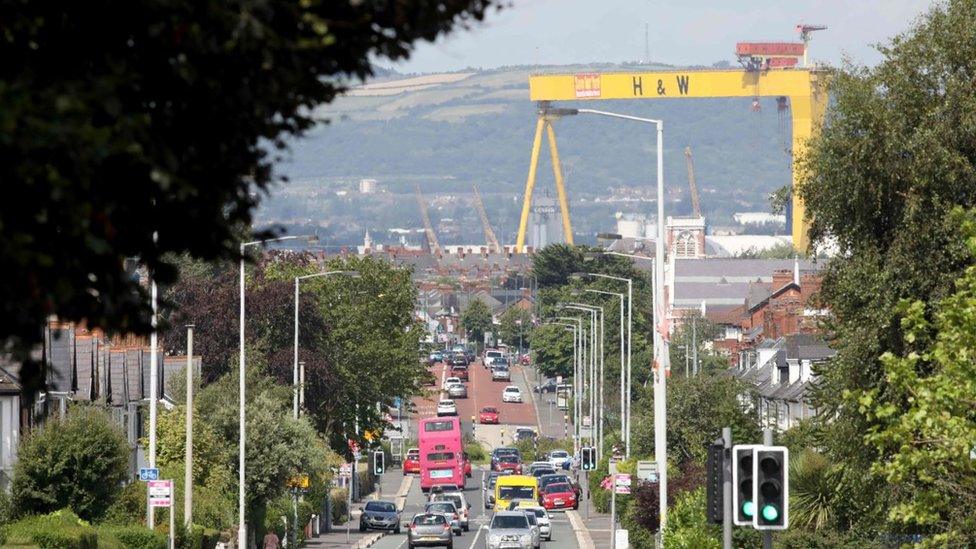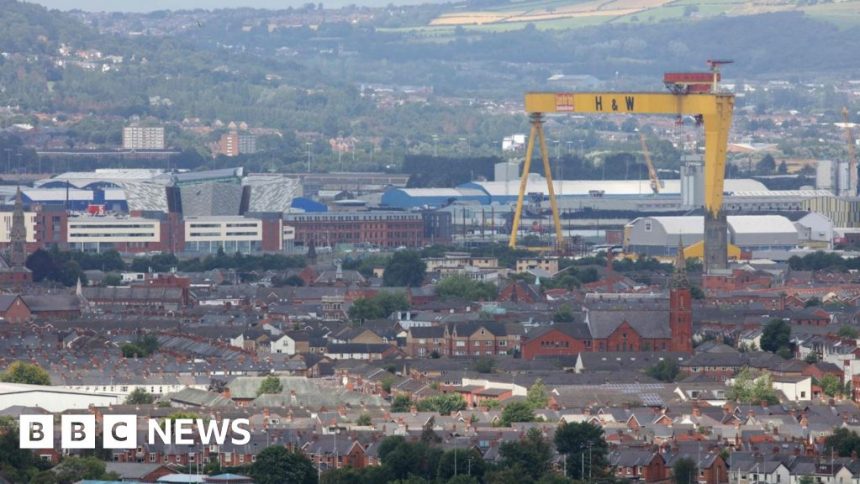Harland and Wolff: What will happen to Belfast’s yellow cranes?
-
Published

Each of the giant cranes has a span of 140m and a safe working load of 840 tonnes
They dominate the skyline and basically say: “Welcome to Belfast.”
The yellow cranes, known affectionately as Samson and Goliath, are significant not just because of their size – they are an iconic part of the city’s psyche.
Plant pots, keyrings, coasters, socks and hot sauce – tourists and locals alike can get the giant cranes’ image on all sorts of merchandise.
They reside in the Harland and Wolff shipyard, which in its early 20th Century heyday was the most prolific builder of ocean liners in the world.
However, it has not been smooth sailing for the shipyard over the past few decades and Harland and Wolff has now gone into administration for the second time in five years.
The administration process is confined to the holding company, while the companies that run the yards will continue to trade.
The cranes are likely to remain no mater what happens the business; they are recognised as monuments in their own right.
When did the cranes appear?
They were a relatively late edition to the shipyard, which was founded in 1861 by Edward James Harland, from Yorkshire, and Gustav Wilhelm Wolff, from Germany.
They are known as gantry cranes – meaning they straddle and overlook their workspace – and are of Krupp Ardelt design, modified to meet Harland and Wolff’s special requirements.
The first, Goliath, was completed in July 1969 and was largely constructed by Harland and Wolff engineers, while the second, Samson, was built by Krupps and finished in May 1974.
So they did not help build the Titanic, the shipyard’s most famous ship.
Since 2003, the cranes have been recognised as official scheduled monuments
Samson is slightly taller than its elder sibling: Goliath stands at 96m (316ft) to Samson’s 106m (348ft).
Each has a span of 140m (459ft) and a safe working load of 840 tonnes.
What could become of the yellow cranes?
While no-one can predict whether any potential buyer would have need for the cranes, they come with their own insurance policy.
Since 2003, the cranes have been recognised as official scheduled monuments.
That means any proposal to alter or remove the cranes would require consent from Stormont’s Department for Communities.
The department said it would work with any future owners of the heritage assets to find ways they can “continue to be used, conserved and appreciated”.
Some 120 jobs are at risk at Harland and Wolff, which employed more than 30,000 people at its peak
John Anderson, of Ulster Architectural Heritage, said the yellow giants were likely to stay – but in what capacity remained unclear.
“They are definitely worth preserving,” he told BBC News NI in 2019.
“They wouldn’t be unique in the world but I would personally like to see them used as an industrial asset.”
However, Mr Anderson said the structures could also become tourist attractions in their own right.
“I wouldn’t endorse it but I could see them becoming a Belfast equivalent of the Eiffel Tower or Statue of Liberty, with people being shipped up to the top to drink expensive coffee,” he joked.
Workers’ unions want the shipyard to be renationalised but the government said the crisis is a commercial issue
Tourists already enjoy recreations of the cranes in various forms – whether it be a painting, miniature model or a snowglobe.
Belfast artist John Stewart said the cranes were so popular they had become the most consistent subject of his work.
“Everybody wants a picture of the cranes – I have customers who order from America, Asia and Australia who perhaps worked at the shipyard 30 years ago,” he told BBC News NI.
“It’s the most famous shipyard in the world and people don’t ask for paintings of anything else.”
Mr Stewart said his fascination with Harland and Wolff started when he was a child.
“I grew up in the shadow of the cranes and and our family business was based not far from the shipyard,” said.
“The ship workers would come by the shop in their hats and their caps to buy tobacco.”
Belfast would not be the same without the cranes, he added.
“Wherever you are, you can always see them.”
Related topics
-
-
Published6 August 2019
-
-
-
Published5 August 2019
-





